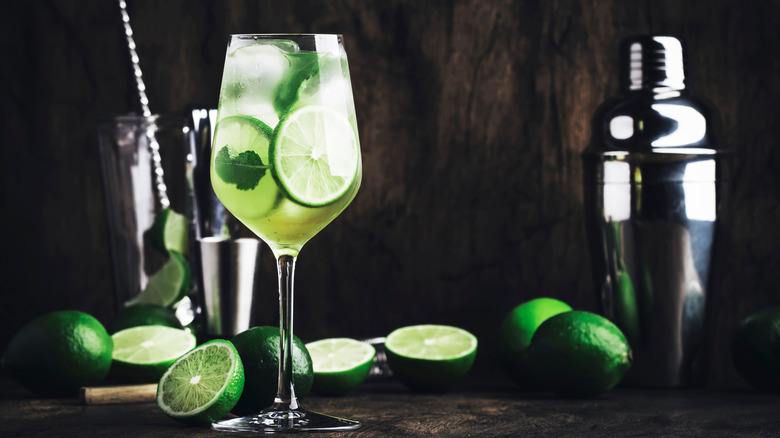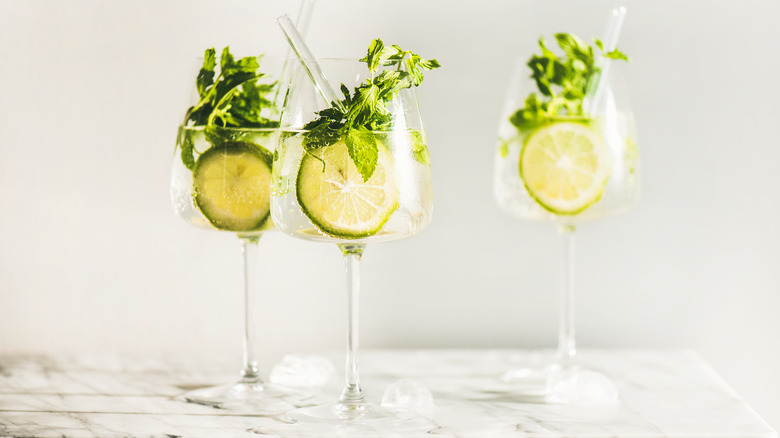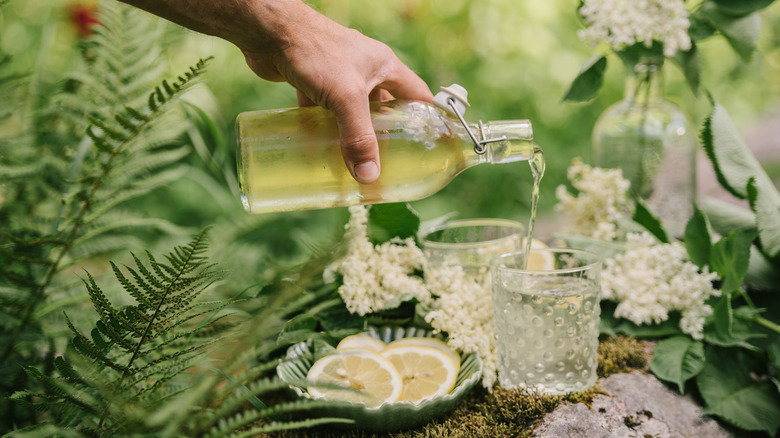The Hugo Spritz Gives The Aperol Classic A Bright, Floral Twist
When the sun's beaming down, it's hard to beat a spritz. Low in alcohol — often containing only 4-5% ABV (alcohol by volume)– it's a cocktail built for easy sipping. Factor in aromatic flavors with a carbonated mouthfeel, and it's no surprise the Italian drink has achieved such global popularity. Of course, the Aperol rendition is the first one that comes to mind, but the style is wide-open to interpretation.
A spritz is defined by the combination of wine and bitter liquor, topped off with sparkling water. Throw in anything from tequila to strawberries — the sky's the limit for flavoring. And while some variations stray far from the Aperol version, others swap out a single ingredient.
Such is the case with the Hugo, a new riff becoming a fixture on menus across Europe. It contains the same core components — prosecco and carbonated water — but replaces the Aperol for Elderflower liqueur. Floral, bright, and rejuvenating, it's an interpretation worth seeking out.
History of the Hugo Spritz
Spritzs emerged at the end of the 19th century in the Veneto region of Northeastern Italy. Back then, the area was controlled by the Austro-Hungarian Empire. Hence the drink's German etymology — spritz means a splash in German. The beverage started from humble origins as a method for Austrian soldiers to water down wine into a drink resembling beer. For most of its existence, the cocktail utilized still white wine.
The version with prosecco was invented by Venetian bartenders in the 1990s. The Aperol inclusion started about a decade later, popularized by a marketing push in the early 2000s. Before it became the ubiquitous go-to, every town across Northern Italy featured its own interpretation. For instance, a village nestled in Italy's Trentino-Alto Adige region in the Dolomites was infamous for a version with elderflower cordial before the invention of the Hugo.
The Hugo in its current form appeared in 2005 at the hands of Italian mixologist Roland Gruber. Born in the mountainous village of Naturno, the drink quickly spread through the Alps, at first in a pre-mixed format. The cocktail's mountainous prevalence aligns with the elderflower's alpine habitat. Such terrain inspired the plant in liquor form — the cornerstone of the Hugo.
The elderflower essence in a Hugo Spritz
This spritz comes together with straightforward proportions — around one part elderflower liquor to one part sparkling water, combined with three parts prosecco. Some mint leaves, along with a lemon or lime slice, go into a glass, and the mixture is stirred together with a spoon. Deviations, adjusted to the taste of the drinker, are frequent.
The elderflower liqueur — which is essential to Hugo's floral flavor — is often the trickiest component to source. It's easiest to find in the form of St. Germain, a French liquor made with elderflower petals infused into a grape-based spirit. This floral spirit can be found in large liquor stores as well as online.
There are also more than a dozen other elderflower liqueur variants, like Italian-made Fiorente or the British Bramley & Gage. Each expression boasts a distinct palette — some more tart, others more honey-like. Most lie in a similar range of alcohol, around 40 proof, but will contribute to a distinct cocktail. And while mainly distributed in Europe, they are also available stateside from boutique sellers.
Another version of the Hugo forgoes the liqueur entirely in favor of non-alcoholic elderflower cordial. This concentrate offers a similar palette, which can be combined with gin to compensate for the lack of booze. Or forgo a higher-proof component altogether for an easy sipping Hugo. Elderflower cordial can be purchased online or even made at home with citric acid.


